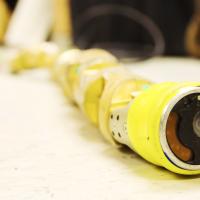Cerebral palsy (CP) is the most common movement disorder in children, and nearly half of kids with CP can’t walk own their own. As bones grow and muscles set incorrectly, walking becomes progressively more difficult. Extensive and repeated surgeries are often required to provide relief, but they can’t solve the underlying problem.
Now, engineers in the Biomechatronics Lab at Northern Arizona University are hoping that robots can lend a hand. They’ve designed lightweight, electrically powered “exoskeletons” for three children with CP to help them walk more easily and more normally. Researchers use computers and motion-capture nodes to model the patient’s gait with different levels of assistance, and then algorithms help refine how the device provides support so that it works smoothly with their own leg motions. The kids also wear a face mask that measures their breathing and estimates how much energy they’re exerting; this ensures that the device isn’t just improving the mechanics of walking by making it more difficult.
So far, they’ve made remarkable progress with a fairly simple design. “It amazes me,” said one researcher, “because this is an exceedingly simple system. Everything about it is very basic — yet it is effective.” Ultimately, they hope that their system will be able to train CP patients’ legs to be able to walk without needing the device. In the next ten years, lead researcher Zach Lerner says that he expects to see wearable robotics routinely used in rehab and treatment, offering a (robotic) helping hand or a leg up for patients with a variety of injuries and diseases.
